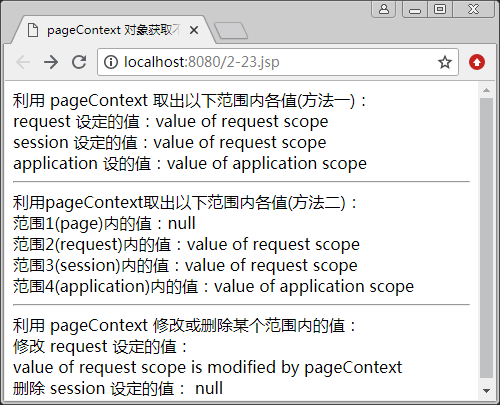- JSP教程
- JSP簡介
- JSP開發(fā)環(huán)境搭建
- Eclipse JSP/Servlet環(huán)境搭建
- JSP結(jié)構(gòu)
- JSP生命周期
- JSP語法
- JSP指令
- JSP page指令
- JSP include指令
- JSP指令應(yīng)用實例
- JSP動作元素
- JSP include動作
- JSP param動作
- JSP forward動作
- JSP plugin動作
- JSP useBean的標準動作
- JSP setProperty動作
- JSP隱式對象
- JSP application對象
- JSP out對象
- JSP request對象
- JSP response對象
- JSP session對象
- JSP pageContext對象
- JSP page對象
- JSP config對象
- JSP客戶端請求
- JSP服務(wù)器響應(yīng)
- JSP HTTP狀態(tài)碼
- JSP表單處理
- JSP過濾器
- JSP Cookies處理
- JSP Session
- JSP文件上傳
- JSP日期處理
- JSP頁面重定向
- JSP點擊量統(tǒng)計
- JSP自動刷新
- JSP發(fā)送郵件
- JSP標準標簽庫(JSTL)
- JSP連接數(shù)據(jù)庫
- JSP XML數(shù)據(jù)處理
- JSP JavaBean
- JSP自定義標簽
- JSP表達式語言
- JSP異常處理
- JSP調(diào)試
- JSP國際化
- JSP特點與工作流程
- JSP與ASP、PHP的比較
- JSP頁面組成及元素
- 第一個JSP程序
- JSP注釋
- JSP聲明
- JSP嵌入Java代碼
- JSP表達式
- JSP開發(fā)模式
- JSP常見錯誤
- JSP獲取并顯示字符串長度
- JSP EL 點(.)運算符和下標([])運算符
- JSP EL算數(shù)運算符
- JSP EL關(guān)系運算符
- JSP EL邏輯運算符
- JSP EL條件運算符
- JSP EL empty空運算符
JSP pageContext對象
JSP 的內(nèi)置對象還包括 pageContext、page、config,在接下來的教程中我們將介紹這些內(nèi)置對象的語法與應(yīng)用。
pageContext 是頁面上下文對象,這個特殊的對象提供了 JSP 程序執(zhí)行時所需要用到的所有屬性和方法,如 session、application、config、out 等對象的屬性,也就是說,它可以訪問本頁所有的 session,也可以取本頁所在的 application 的某一屬性值,它相當(dāng)于頁面中所有其他對象功能的集大成者,可以用它訪問本頁中所有的其他對象。
pageContext 對象是 javax.servlet:jsp.pageContext 類的一個實例,它的創(chuàng)建和初始化都是由容器來完成的,JSP 頁面里可以直接使用 pageContext 對象的句柄,pageContext 對象的 getXxx()、setXxx() 和 findXxx() 方法可以根據(jù)不同的對象范圍實現(xiàn)對這些對象的管理。表 1 列出了 pageContext 對象的常用方法。
表1 pageContext對象的常用方法
|
方法 |
說明 |
|---|---|
|
void forward(String relativeUrlPath) |
把頁面轉(zhuǎn)發(fā)到另一個頁面或者 Servlet 組件上 |
|
Exception getException() |
返回當(dāng)前頁的 Exception 對象 |
|
ServletRequest getRequest() |
返回當(dāng)前頁的 request 對象 |
|
ServletResponse getResponse() |
返回當(dāng)前頁的 response 對象 |
|
ServletConfig getServletConfig() |
返回當(dāng)前頁的 ServletConfig 對象 |
|
HttpSession getSession() |
返回當(dāng)前頁的 session 對象 |
|
Object getPage() |
返回當(dāng)前頁的 page 對象 |
|
ServletContext getServletContext() |
返回當(dāng)前頁的 application 對象 |
|
public Object getAttribute(String name) |
獲取屬性值 |
|
Object getAttribute(String name,int scope) |
在指定的范圍內(nèi)獲取屬性值 |
|
void setAttribute(String name,Object attribute) |
設(shè)置屬性及屬性值 |
|
void setAttribute(String name,Object obj,int scope) |
在指定范圍內(nèi)設(shè)置屬性及屬性值 |
|
void removeAttribute(String name) |
刪除某屬性 |
|
void removeAttribute(String name,int scope) |
在指定范圍內(nèi)刪除某屬性 |
|
void invalidate() |
返回 servletContext 對象,全部銷毀 |
pageContext 對象的主要作用是提供一個單一界面,以管理各種公開對象(如 session、application、config、request、response 等),提供一個單一的 API 來管理對象和屬性。
例1:通過 pageContext 對象取得不同范圍的屬性值,代碼如下:
<%@ page contentType="text/html;charset=utf-8" %>
<html>
<head>
<title>
pageContext 對象獲取不同范圍屬性
</title>
</head>
<body>
<%
request.setAttribute("info","value of request scope");
session.setAttribute("info","value of request scope");
application.setAttribute("info","value of application scope");
%>
利用 pageContext 取出以下范圍內(nèi)各值(方法一):<br>
request 設(shè)定的值:<%=pageContext.getRequest().getAttribute("info") %> <br>
session 設(shè)定的值:<%=pageContext.getSession().getAttribute("info") %> <br>
application 設(shè)的值:<%=pageContext.getServletContext().getAttribute("info") %> <hr>
利用pageContext取出以下范圍內(nèi)各值(方法二):<br>
范圍1(page)內(nèi)的值:<%=pageContext.getAttribute("info",1) %> <br>
范圍2(request)內(nèi)的值:<%=pageContext.getAttribute("info",2) %> <br>
范圍3(session)內(nèi)的值:<%=pageContext.getAttribute("info",3) %> <br>
范圍4(application)內(nèi)的值:<%=pageContext.getAttribute("info",4) %> <hr>
利用 pageContext 修改或刪除某個范圍內(nèi)的值:
<% pageContext.setAttribute("info","value of request scope is modified by pageContext",2); %> <br>
修改 request 設(shè)定的值:<br>
<%=pageContext.getRequest().getAttribute("info") %> <br>
<% pageContext.removeAttribute("info"); %>
刪除 session 設(shè)定的值:<%=session.getAttribute("info") %>
</body>
</html>
運行結(jié)果如圖 1 所示。

圖1 通過pageContext對象取得不同范圍的屬性值
提示:
pageContext 對象在實際 JSP 開發(fā)過程中很少使用,因為 request 和 response 等對象可以直接調(diào)用方法進行使用,而通過 pageContext 來調(diào)用其他對象,會覺得有些麻煩。






